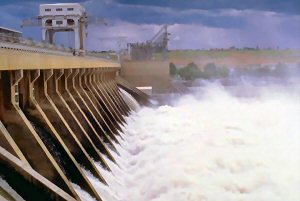forum
library
tutorial
contact

Feds Take Another Crack
at Salmon-Dam Balance
by News Sources
Bend.com, September 9, 2004
|
the film forum library tutorial contact |

|
Feds Take Another Crack
by News Sources
|
Feds commit $6 billion (at least) to salmon assist
 The three agencies that run the federal hydropower system in the Pacific Northwest released a proposed 10-year operation plan for the system Thursday that embraces what they called an “aggressive set of measures to protect salmon.”
The three agencies that run the federal hydropower system in the Pacific Northwest released a proposed 10-year operation plan for the system Thursday that embraces what they called an “aggressive set of measures to protect salmon.”
At the same time, the National Oceanic and Atmospheric Administration’s National Marine Fisheries Service (NOAA Fisheries) released an extensive analysis of the agencies’ plan that said the proposal will not jeopardize the continued existence of 13 populations of salmon and steelhead now under federal protection in the Columbia River Basin.
The new analysis, still in draft stage, is known as a biological opinion and is a requirement of the Endangered Species Act.
The biological opinion governs how the basin’s hydropower system must be operated to minimize harm to salmon that the environmental law protects.
The new draft opinion comes in response to a decision by a federal court last year that ruled an earlier biological opinion, written in 2000, did not contain sufficient guarantees that certain actions to help salmon would be implemented.
The new draft, which was delivered to the court Thursday morning, provides greater details about habitat improvements and hatchery operations throughout the Columbia River watershed. It incorporates the latest scientific findings on the fundamental biological needs of each salmon species.
Most importantly, the three “action agencies” that operate the dams – Bonneville Power Administration, the Army Corps of Engineers and the Bureau of Reclamation – are proposing specific actions in the operation of the dams that taken as a whole will not jeopardize the existence of the protected stocks.
“This operation plan continues an aggressive and sensible approach to salmon protection in the Columbia River Basin, with a firm commitment up front to protect salmon,” said Bob Lohn, head of NOAA Fisheries Northwest regional office in Seattle. “It’s a significant achievement that can benefit both the region and its fish.”
The salmon-helping actions that the federal action agencies are committed to include installing multi-million-dollar fish-guiding devices at dams to improve fish passage and survival, targeting fish and wildlife funding for habitat improvements and reforming hatcheries to boost naturally spawning runs in key areas.
"One area where we've seen good results is surface-oriented passage for juvenile fish at the dams," said Brig. Gen. William Grisoli, commander of the Corps Northwestern Division. "With continued regional support, we hope to step up our efforts for such promising innovations
NOAA Fisheries said an important consideration in its decision that the operation of the dams would not jeopardize the existence of protected salmon stocks was the improved operation of the dams themselves, tempered by the federal agencies’ proposed salmon-helping actions.
The fisheries agency added that a significant factor in its “no-jeopardy to the continued existence of the species” determination was the expected improvement brought about by efforts to substantially reduce predation on young salmon by northern pikeminnow. Longer-term reduction of bird predation in the Columbia River estuary was also key to the no-jeopardy finding, along with dam operators’ commitments to structural improvements to dams to aid juvenile salmon passage.
The draft biological opinion embodies what’s known as a performance-based approach.
“Effective salmon enhancement through the most efficient means possible – that’s the theme of the federal dam operators’ proposal,” said Bill McDonald, regional director for Reclamation. “The performance targets for the hydro system provide clear but flexible objectives for evaluating the success of actions under this draft biological opinion.”
The federal dam operators’ proposed operation includes current levels of summer spill but leaves the door open to modifications if more cost-effective means for achieving the same biological performance can be implemented.
“Implementation of the federal dam operators’ proposal, along with other actions being taken in the Columbia River Basin would mean the federal commitment to salmon enhancement funding will be in the range of $6 billion over the next 10 years,” said Steve Wright, BPA administrator. “Modifications to hydrosystem operations that reduce electricity production will increase these costs.”
For the past three years, the federal agencies noted, the Northwest has experienced record and near-record returns for a variety of adult salmon species. Good ocean conditions and improvements to the ecosystem affecting the entire life cycle of the salmon have contributed greatly to these good returns.
The draft went out Thursday for review and comment by state and tribal co-managers and by the region’s stakeholders before a final biological opinion at the end of November. For more information, please see www.salmonrecovery.gov.
learn more on topics covered in the film
see the video
read the script
learn the songs
discussion forum
